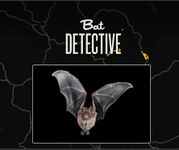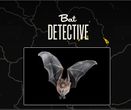Bat detective: Difference between revisions
Jump to navigation
Jump to search
mNo edit summary |
mNo edit summary |
||
| (3 intermediate revisions by one other user not shown) | |||
| Line 10: | Line 10: | ||
|field_cs_subject_areas=nature/conservation | |field_cs_subject_areas=nature/conservation | ||
|field_fields_of_science=zoology | |field_fields_of_science=zoology | ||
|field_project_description=Bat Detective is an Zooniverse citizen science project which asks the public to turn detective to find bat calls in audio recordings across the world | |field_project_description=Bat Detective is an Zooniverse citizen science project which asks the public to turn detective to find bat calls in audio recordings across the world | ||
|field_purpose_of_project=Mapping out bat ‘hotspots’ by using recordings and classifying the sounds they make for echolocation and social purposes. | |field_purpose_of_project=Mapping out bat ‘hotspots’ by using recordings and classifying the sounds they make for echolocation and social purposes. | ||
|field_research_questions=Calls that bats use for socialising are not used for echolocation but communication, and these calls tend to be lower in frequency and have a more complex structure. Only under a third of all the echolocation calls of bats worldwide are known and even less is understood about social calls. Perhaps only 5% of all species social calls have been recorded. | |field_research_questions=Calls that bats use for socialising are not used for echolocation but communication, and these calls tend to be lower in frequency and have a more complex structure. Only under a third of all the echolocation calls of bats worldwide are known and even less is understood about social calls. Perhaps only 5% of all species social calls have been recorded. | ||
| Line 17: | Line 17: | ||
|field_partner_institutions=Zoological Society of London, The Bat Conservation Trust, BatLife Europe, University of Auckland, the Citizen Science Alliance. | |field_partner_institutions=Zoological Society of London, The Bat Conservation Trust, BatLife Europe, University of Auckland, the Citizen Science Alliance. | ||
|field_team_link=http://www.batdetective.org/#!/about/team/science | |field_team_link=http://www.batdetective.org/#!/about/team/science | ||
|field_contact_person=Bat detect team on twitter | |||
|field_contact_person_URLs=https://twitter.com/batdetect | |||
|field_team_location=University College London | |field_team_location=University College London | ||
|field_participant_task_description=Participants are required to differentiate between a bat and a non-bat call, the different types of calls and what sequence a call belongs in. | |||
|field_Haklay_typology=crowdsourcing | |field_Haklay_typology=crowdsourcing | ||
|field_volonteer_computing=no | |field_volonteer_computing=no | ||
| Line 25: | Line 28: | ||
|field_data_types_to_manipulate=sound | |field_data_types_to_manipulate=sound | ||
|field_participant_contribution_type=data interpretation | |field_participant_contribution_type=data interpretation | ||
|field_interaction_with_objects=The user will categorise bat calls by listening to, and looking at visualisations of, bat call recordings. | |||
|field_interface_attractivity=cool/attractive | |field_interface_attractivity=cool/attractive | ||
|field_interface_usability=easy to use | |field_interface_usability=rather easy to use | ||
|field_tutorials_documentation=yes | |field_tutorials_documentation=yes | ||
|field_peer_to_peer_guidance=N/A | |field_peer_to_peer_guidance=N/A | ||
| Line 34: | Line 38: | ||
|field_research_progress_feedback=N/A | |field_research_progress_feedback=N/A | ||
|field_member_profiles=N/A | |field_member_profiles=N/A | ||
|field_community_tools=website, blog, other | |||
|field_number_of_forum_members=671 | |field_number_of_forum_members=671 | ||
|field_has_community_manager=N/A | |field_has_community_manager=N/A | ||
|field_project_news_updates= | |field_project_news_updates=less than weekly | ||
|field_socialsoftware_sites= | |field_project_news_site=http://blog.batdetective.org/ | ||
|field_socialsoftware_sites=Twitter, Facebook, other | |||
|field_event_types=other | |||
|field_events_frequency=5 | |||
|field_community_management=Blog contains most of the news/community updates. There was a google hangout with the bat detective team on 20/12/2013. Although there is some community participation in the comments, the blog is rather quiet(the last post was made on 7/2/2013). The twitter feed (@batdetect) is more active, as is the facebook page (https://www.facebook.com/batdetective). | |||
|field_community_interaction_forms=Twitter and http://talk.batdetective.org/ | |||
|field_team_work=N/A | |field_team_work=N/A | ||
|field_completion_level= | |field_community_awareness_tools=Various science blogs and an appearance on BBC news | ||
|field_last_edition=2013/09 | |field_completion_level=High | ||
|field_last_edition=2013/12/09 | |||
}} | }} | ||
{{Free text}} | {{Free text}} | ||
The signup/login process is not working as of 9/12/2013 on firefox, chrome or safari. The project does not look particularly active at the moment. | |||
{{bibliography | |||
|field_author=Bat detective team | |||
|field_link=https://twitter.com/batdetect | |||
|field_publication_type=other | |||
}} | |||
{{bibliography | |||
|field_author=Unknown | |||
|field_title=Bat Detective | |||
|field_link=http://www.scientificamerican.com/citizen-science/project.cfm?id=zooniverse-bat-detective | |||
|field_publication_type=Research article | |||
|field_additional_information=Part of the Citizen Science section of the Scientific American Website | |||
}} | |||
{{bibliography | |||
|field_author=Mark Kinver | |||
|field_title=Website calls on people to become 'bat detectives' | |||
|field_link=http://www.bbc.co.uk/news/science-environment-19803167 | |||
|field_publication_type=Newspaper | |||
}} | |||
{{bibliography | |||
|field_author=Lily Bui | |||
|field_title=Become a Bat Detective | |||
|field_link=http://scistarter.com/blog/2012/10/become-a-bat-detective/ | |||
|field_publication_type=Blog | |||
}} | |||
Latest revision as of 17:43, 12 September 2018
| BIBLIOGRAPHY |
The signup/login process is not working as of 9/12/2013 on firefox, chrome or safari. The project does not look particularly active at the moment.



